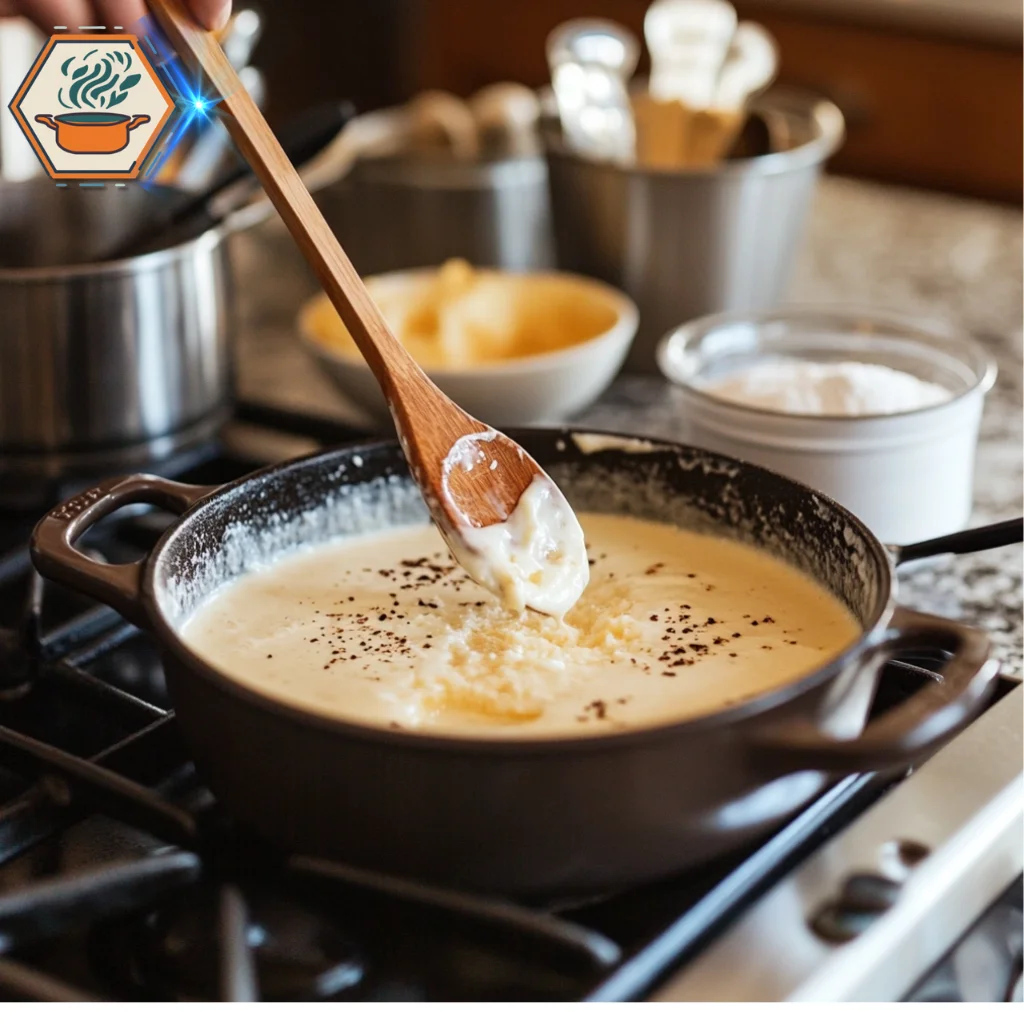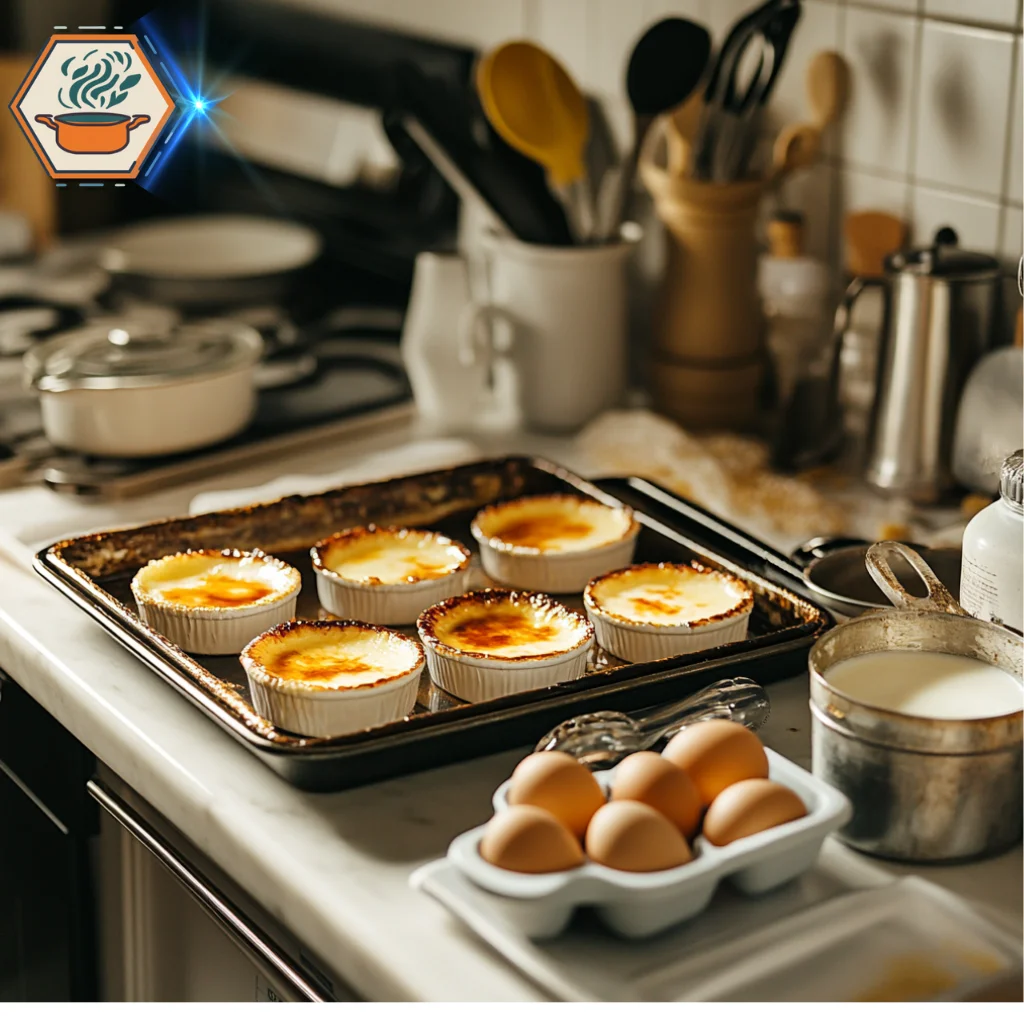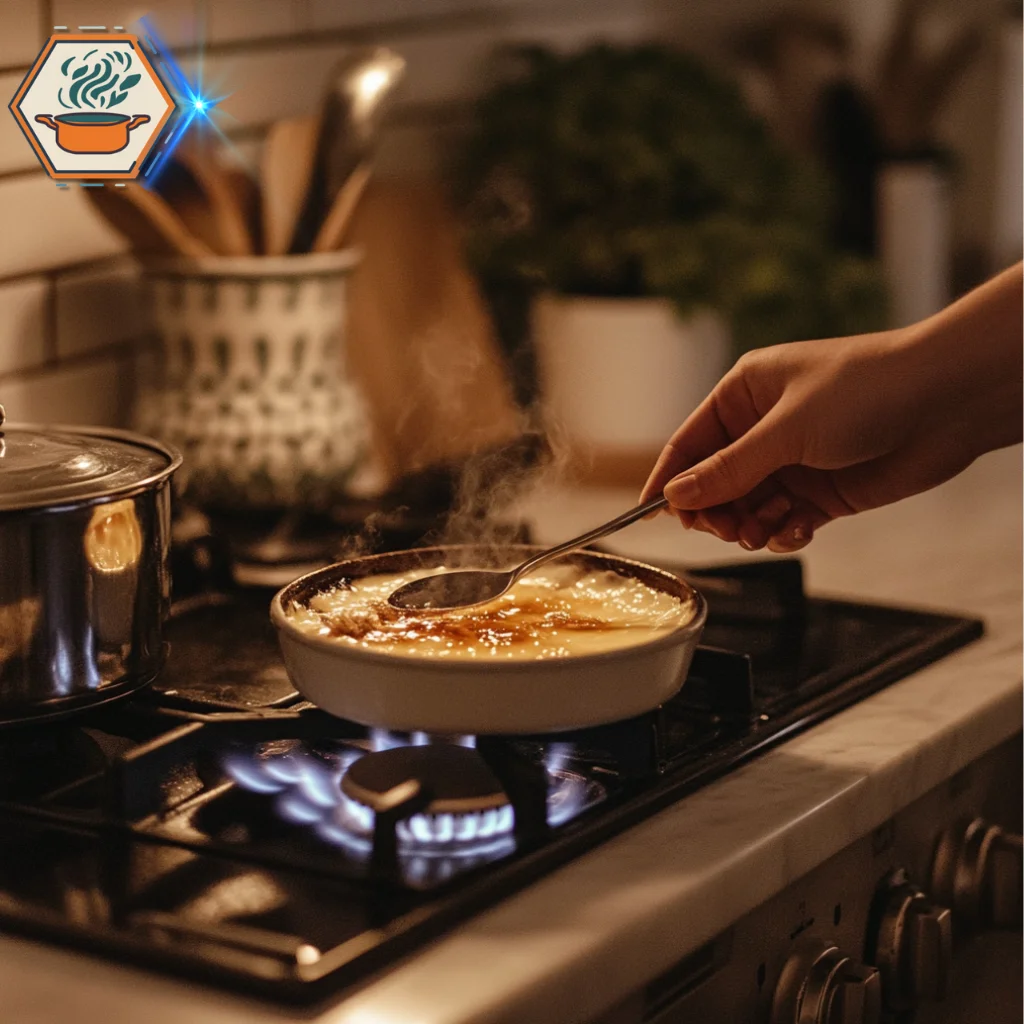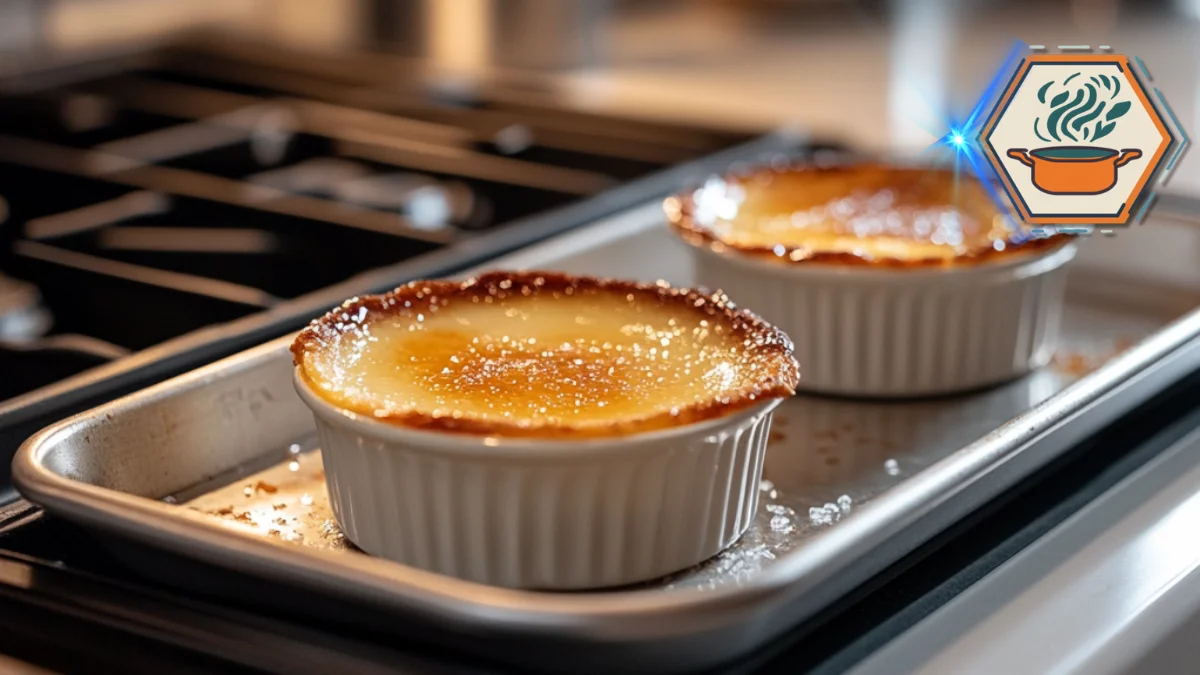Table of Contents
Mastering Crème Brûlée Basics
Introduction to Crème Brûlée
What is Crème Brûlée?
Crème brûlée is a classic French dessert known for its creamy custard base and its signature crispy caramelised sugar top. If you’ve ever wondered how to caramelise crème brûlée without a blowtorch, this guide is here to help. We will show you practical and effective methods for creating the perfect caramelised sugar topping without the need for a blowtorch.
The name crème brûlée translates to “burnt cream” in French, which perfectly describes the dessert’s contrasting textures: a smooth, rich custard beneath a layer of caramelised sugar that cracks beautifully when tapped with a spoon.
This delicate dessert is typically served in individual ramekins and is often a symbol of sophistication in fine dining. Despite its luxurious reputation, crème brûlée is surprisingly simple to make at home, requiring only a handful of ingredients and some careful techniques for the perfect finish.
Key Ingredients and Equipment for Caramelising Crème Brûlée Without a Blowtorch

Essential Ingredients: Cream, Sugar, Eggs, and Vanilla
The beauty of crème brûlée lies in its simplicity. You only need a few staple ingredients:
- Heavy Cream: Provides the rich and velvety texture for the custard base.
- Egg Yolks: Act as the thickening agent, creating a luscious consistency.
- Granulated Sugar: Sweetens the custard and is essential for the caramelised top.
- Vanilla Bean or Extract: Adds a warm, aromatic flavor that complements the creamy base.
For an authentic touch, using a fresh vanilla bean instead of extract will enhance the flavor and create those beautiful specks of vanilla seeds throughout the custard.
Typical Tools for Caramelising Crème Brûlée Without a Blowtorch
Forming the iconic sugar crust involves applying intense heat to melt and caramelise the sugar. If you don’t have a blowtorch, here are the most common alternative tools used:
- Oven Broiler: An effective method for caramelising crème brûlée using direct heat from your oven.
- Heated Spoon: A creative method where a heated metal spoon is used to melt the sugar.
- Caramelised Sugar Syrup: Pouring pre-prepared caramel over the custard creates a similar effect.
These alternatives allow you to achieve the perfect caramelised sugar crust without relying on a blowtorch.
Understanding the Science of Caramelising Crème Brûlée Without a Blowtorch
How Sugar Turns into Caramel: The Maillard Reaction
The process of sugar turning into caramel involves a chemical reaction known as the Maillard reaction. When sugar is heated to high temperatures (around 300°F or 150°C), its molecules break down and undergo a series of complex reactions, creating new compounds that produce caramel’s distinctive golden-brown color and deep, slightly bitter flavor.
The Maillard reaction not only enhances the flavor but also adds the signature crunch that balances the creamy custard of crème brûlée.
Choosing the Best Sugar for Caramelising Crème Brûlée Without a Blowtorch
Choosing the right sugar is crucial for achieving the perfect caramelised layer. Here are the most commonly used types:
- Granulated Sugar: The standard choice for its fine texture and even melting properties.
- Demerara Sugar: Known for its large crystals and subtle molasses flavor, which adds depth to the caramelised top.
- Caster Sugar: Finer than granulated sugar, it melts quickly and evenly, ideal for delicate caramelisation.
For beginners, granulated sugar is the safest option, as it is widely available and easy to work with.
Why Caramelising Crème Brûlée Without a Blowtorch is Popular
Benefits of Using Alternative Methods for Caramelisation
Using a blowtorch is the traditional method for caramelising crème brûlée, but alternative methods offer several benefits:
- Accessibility: Not everyone owns a blowtorch, making alternatives more practical.
- Safety: Using tools like oven broilers or spoons eliminates safety concerns associated with open flames.
- Cost-Effective: Alternatives like broilers and sugar syrup require no additional equipment.
These methods allow you to achieve the same crispy, caramelised sugar top without a blowtorch, making the process accessible to every home cook.
How to Caramelise Crème Brûlée Without a Blowtorch: Step-by-Step Methods

Using the Oven Broiler to Caramelise Crème Brûlée
The oven broiler is one of the most accessible alternatives for caramelising crème brûlée. It allows for direct heat application similar to a blowtorch.
- Prepare the Ramekins: Once the custard is chilled, sprinkle a thin layer of sugar evenly over the surface.
- Preheat the Broiler: Set your oven to its highest broil setting and allow it to preheat.
- Broil the Sugar: Place the ramekins on the top rack, approximately 3-4 inches from the heat source.
- Monitor Closely: Broil for 2-5 minutes, rotating as needed to ensure even caramelisation.
- Cool and Serve: Once the sugar has melted and turned golden brown, allow it to set before serving.
Heated Spoon Technique for Caramelising Crème Brûlée
If you don’t have access to an oven broiler, you can use a heated spoon:
- Heat a Metal Spoon: Hold a sturdy metal spoon over an open flame until very hot.
- Sprinkle Sugar: Evenly distribute a thin layer of sugar on the custard.
- Press and Melt: Gently press the back of the heated spoon onto the sugar to caramelise it.
- Work in Sections: Repeat until the entire surface is caramelised.
This method is ideal for small batches and is a creative alternative to traditional tools.
For a deeper dive into dessert techniques, check out our recipe for What is a knafeh chocolate bar?
You can also explore the science of caramelisation on Wikipedia’s Caramelisation page.
Alternative Ways to Caramelize Crème Brûlée Without a Blowtorch
Crème brûlée is a classic French dessert loved for its creamy custard base and crunchy caramelised sugar topping. While a blowtorch is the traditional tool used to achieve that signature caramel crunch, not everyone has one in their kitchen. Fortunately, there are several alternative methods to caramelise crème brûlée without a blowtorch. In this guide, we will explore four effective techniques to help you create the perfect caramelised topping with tools you likely already own.
Method 1: Using the Oven Broiler
The oven broiler is one of the most accessible alternatives for caramelising crème brûlée. It allows for direct heat application similar to a blowtorch.
Step-by-Step Guide to caramelise crème brûlée without a blowtorch Under a Broiler
- Prepare the crème brûlée: Once the custard has chilled and set, sprinkle a thin, even layer of granulated sugar over the surface.
- Preheat the broiler: Set your oven to its highest broil setting and allow it to preheat for a few minutes.
- Position the ramekins: Place the ramekins on a baking tray and position them on the top rack, approximately 3-4 inches from the broiler element.
- Monitor closely: Broil for 2-5 minutes, keeping a constant eye on the sugar. Turn the ramekins as needed to achieve even caramelization.
- Remove and cool: Once the sugar has melted and formed a golden crust, remove the ramekins and allow them to cool slightly before serving.
Tips to Achieve an Even Caramelisation
- Use a fine sugar, such as caster sugar, which melts more evenly.
- Rotate the ramekins during broiling to avoid uneven browning.
- Avoid overloading the sugar, as it can lead to burning or a grainy texture.
Common Mistakes to Avoid
- Leaving the ramekins unattended can result in burnt sugar.
- Placing the ramekins too close to the broiler can scorch the sugar.
- Using thick layers of sugar makes it harder to achieve a smooth crust.
Method 2: The Spoon Technique
If you don’t have access to a broiler, a simple metal spoon can help you caramelise sugar effectively. This method requires precision and patience but can yield excellent results.
How to Heat a Metal Spoon for Sugar Caramelisation

- Choose the right spoon: Use a sturdy metal spoon with a flat surface.
- Heat the spoon: Hold the spoon over an open flame (like a gas stove) or place it on a hot electric burner. Heat until the spoon is very hot but not glowing red.
- Sprinkle sugar on the custard: Add an even layer of sugar over the crème brûlée.
- Press and caramelise: Gently press the back of the hot spoon onto the sugar. The heat will melt and caramelise the sugar on contact.
Best Practices for Safety and Precision
- Use heat-resistant gloves or tongs to handle the hot spoon.
- Test the spoon’s heat on a small area before fully committing.
- Work quickly to prevent the spoon from cooling down.
When This Method Works Best
This method is ideal for small batches and when you lack access to other heating tools. However, it may not be suitable for larger portions.
Method 3: Caramelised Sugar Syrup
Another alternative to caramelise crème brûlée without a blowtorch is by using a prepared sugar syrup. This method avoids direct heat application.
Preparing a Sugar Syrup for a Caramelised Topping
- Combine sugar and water: In a saucepan, mix 1 cup of sugar with 2 tablespoons of water.
- Heat the syrup: Cook over medium heat, stirring occasionally until the sugar melts and turns a golden caramel colour.
- Cool slightly: Let the syrup cool for 1-2 minutes to thicken slightly.
Pouring and Setting the Syrup Evenly on the Crème Brûlée
- Pour carefully: Slowly drizzle the caramel syrup over the custard, covering the entire surface.
- Set the topping: Allow the syrup to harden and form a glass-like crust.
Pros and Cons of This Method
Pros:
- Requires no special tools.
- Produces a consistent caramel topping.
Cons:
- Syrup can harden too quickly, making it challenging to spread.
- Overcooking the syrup can result in a bitter flavour.
Method 4: Kitchen Torch Substitutes
If you want a handheld approach but lack a kitchen torch, some unconventional tools might work as substitutes.
Exploring Other Handheld Tools
- Candle flame: A candle can provide localized heat, but it may take longer and is less consistent.
- Lighter: A standard lighter can caramelise small areas but is inefficient for large surfaces.
- Electric lighters: Battery-operated lighters produce more heat than traditional lighters and can work in a pinch.
Are These Alternatives Practical?
While these tools can work, they are best suited for emergencies or very small batches. They often lack the power and consistency of a broiler or blowtorch.
Safety Precautions and Efficiency Tips
- Keep flammable materials away from the flame.
- Use heat-resistant tongs or gloves to protect your hands.
- Work in a well-ventilated area to avoid smoke buildup.
Tips to Perfect Caramelisation Without a Blowtorch
Choosing the Right Sugar for Best Results
- Use caster sugar or fine granulated sugar for even melting.
- Avoid large sugar crystals, which take longer to melt.
Avoiding a Burnt or Grainy Texture
- Spread the sugar in a thin, even layer.
- Avoid overcooking under the broiler or when heating syrup.
Balancing Caramel Flavour with Custard Texture
- Let the caramel topping cool for a few minutes before serving to maintain a crisp texture.
- Avoid thick caramel layers that overpower the delicate custard.
For more kitchen techniques, explore our guide on How do you eat tempura chicken?.
FAQs: Common Questions About Caramelising Crème Brûlée
Can I Use a Lighter or Candle to caramelise crème brûlée without a blowtorch?
Yes, but it’s less efficient and works best for small areas.
What is the Best Sugar for Caramelisation Without a Blowtorch?
Fine granulated sugar or caster sugar is ideal for even and quick caramelisation.
Can I Prepare the Topping Ahead of Time?
It’s best to caramelise the sugar just before serving to maintain its crispness.
Why Does My Sugar Not Caramelise Evenly?
Uneven sugar layers or improper heat distribution can lead to uneven caramelisation.
Conclusion
While a blowtorch is a convenient tool for caramelising crème brûlée, there are several effective alternatives. Whether you use the oven broiler, a heated metal spoon, caramelised sugar syrup, or unconventional tools like lighters, each method offers unique advantages. Choose the method that best suits your kitchen setup and enjoy a perfectly caramelised crème brûlée every time.


2 thoughts on “How to caramelise crème brûlée without a blowtorch?”